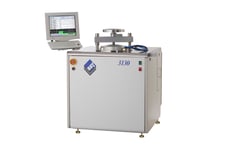It seems that we upgrade phones, software, and computers every couple of years to take advantage of the latest and most reliable technology available. It’s not a large investment and keeps us up to date with the world around us. Sometimes though, we want to run our old cars until they give out, because a new one is a major  investment. But in doing so we sacrifice technological improvements, safety, reliability, and sometimes the ability to service or repair the car due to obsolescence of parts or lack of mechanics who have knowledge of older vehicles. And when a repair is needed, it can exceed the value of the car itself!
investment. But in doing so we sacrifice technological improvements, safety, reliability, and sometimes the ability to service or repair the car due to obsolescence of parts or lack of mechanics who have knowledge of older vehicles. And when a repair is needed, it can exceed the value of the car itself!
Is it the same situation for older vacuum reflow systems? At SST, we hear from customers who are operating systems purchased up to 30 years ago, and we are gratified that the robust features we build into our systems are proved out. This level of reliability and durability has been a key to our success, and established SST as the leading supplier of chamber-based vacuum/pressure furnaces for void-free/flux free die attach and hermetic lid seal processes to the global microelectronics industry.
However, the original SST systems (including the DAP-2200 and its successor, the MV-2200) were conceived in the 1980s and served the market well. They were designed to accommodate the standards of that era, not today’s more stringent requirements in our fast-changing industry. Additionally, the lack of precise digital controls, the obsolescence of spare parts, and reduced access to factory services challenges the manufacturing engineer to deliver consistent quality and high yields on these obsolete models.
Customer engineers have displayed considerable ingenuity to keep these old systems running, but the absence of critical support services clearly represents risk, and requires the allocation of company resources to keep these systems operating. Ultimately, the hidden costs of ownership that every user of an old model is paying disappear with a new SST furnace.
SST’s current range of vacuum reflow systems expand capabilities to achieve higher performance levels on a wider range of complex package types and applications. The newest systems—both the 3130 and the 5100—have Microsoft Windows®-based digital control of process parameters with a user-edited program for each application and LCD display, and independent programming of vacuum levels. Also, they have gas pressures and flow rates, an enhanced control system such as real-time graphing of temperature and pressure, as well as features an operator touch screen. These systems also have vacuum pump options, in-situ moisture and oxygen analyzers, and other feedback tools to aid the process engineer in achieving his or her objective. Software upgrades are easy to install and keep your system current.
wider range of complex package types and applications. The newest systems—both the 3130 and the 5100—have Microsoft Windows®-based digital control of process parameters with a user-edited program for each application and LCD display, and independent programming of vacuum levels. Also, they have gas pressures and flow rates, an enhanced control system such as real-time graphing of temperature and pressure, as well as features an operator touch screen. These systems also have vacuum pump options, in-situ moisture and oxygen analyzers, and other feedback tools to aid the process engineer in achieving his or her objective. Software upgrades are easy to install and keep your system current.
Our recent launch of QuikCoolTM as an option for the Model 5100 enables a rapid cooldown cycle and reduced void levels. Combined with the 5100’s large 12” x 12” chamber size and temperature uniformity, QuikCool achieves dramatic improvements in throughput. Both new systems have ease of use that contribute to tighter process control, higher yields, and increased throughput.
So while our old car got us from point A to point B, a new car with every electronic convenience like navigation, wireless connections, and heated seats gets us there reliably, on time, and safely without worry. If you feel the same about your older SST system, please contact your SST sales representative to assist you with your requirements.
Download these resources for more information on some of our latest systems and solutions:
| Model 3130 Data Sheet | Model 5100 Data Sheet | QuikCool™ Data Sheet |
----
Matt Vorona
Sales Manager
SST International
Photo credit: http://f.tqn.com/y/autorepair/1/W/T/t/7/-/108441867-crop.jpg